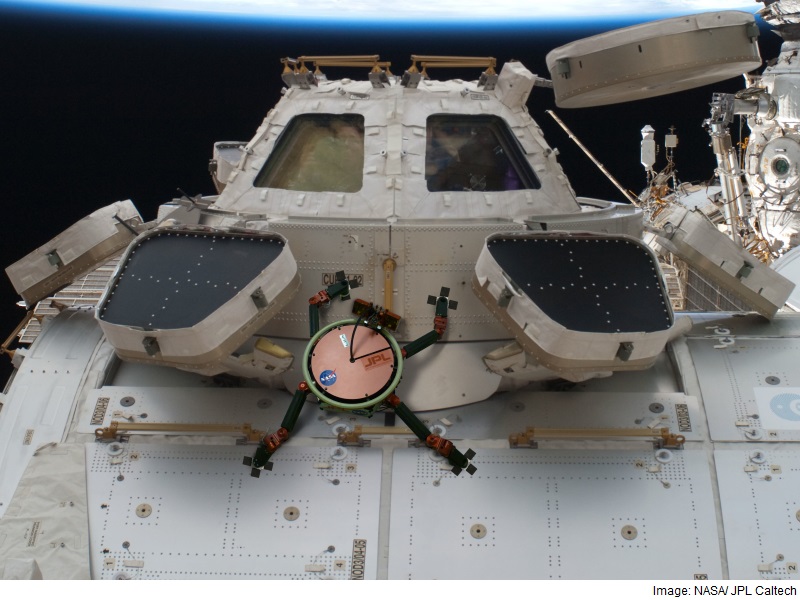- Home
- Science
- Science News
- Nasa Testing Climbing Space Robot With Sticky Gecko Feet
Nasa Testing Climbing Space Robot With Sticky Gecko Feet

Thanks to tiny hair on the bottom of geckos' feet, these lizards can cling to walls with ease, and their stickiness doesn't wear off with repeated usage.
Aaron Parness from Nasa's Jet Propulsion Laboratory in California and colleagues used that concept to create a material with synthetic hairs that are much thinner than a human hair.
When a force is applied to make the tiny hairs bend, that makes the material stick to a desired surface.
"This is how the gecko does it, by weighing its feet," Parness said.
The newest generation of grippers can support more than 150 Newtons of force, the equivalent of 16 kilogrammes.
In a microgravity flight test last year through Nasa's Space Technology Mission Directorate's Flight Opportunities Programme, the gecko-gripping technology was used to grapple a 10 kilogramme cube and a 100 kilogramme person.
Researchers have more recently made three sizes of hand-operated "astronaut anchors," which could one day be given to astronauts inside the ISS.
The anchors are made currently in footprints of 1 by 4 inches, 2 by 6 inches and 3 by 8 inches.
They would serve as an experiment to test the gecko adhesives in microgravity for long periods of time and as a practical way for astronauts to attach clipboards, pictures and other handheld items to the interior walls of the station.
Astronauts would simply attach the object to the mounting post of the gripper by pushing together the two components of the gripper.
Parness and colleagues are collaborating with Nasa's Johnson Space Centre in Houston on this concept.
They are also testing the Lemur 3 climbing robot, which has gecko-gripper feet, in simulated microgravity environments.
The team thinks possible applications could be to have robots like this on the space station conducting inspections and making repairs on the exterior.
For testing, the robot manoeuvres across mock-up solar and radiator panels to emulate that environment.
There are numerous applications beyond the space station for this technology, Nasa said.
"We might eventually grab satellites to repair them, service them, and we also could grab space garbage and try to clear it out of the way," Parness said.
Get your daily dose of tech news, reviews, and insights, in under 80 characters on Gadgets 360 Turbo. Connect with fellow tech lovers on our Forum. Follow us on X, Facebook, WhatsApp, Threads and Google News for instant updates. Catch all the action on our YouTube channel.
Related Stories
- Samsung Galaxy Unpacked 2025
- ChatGPT
- Redmi Note 14 Pro+
- iPhone 16
- Apple Vision Pro
- Oneplus 12
- OnePlus Nord CE 3 Lite 5G
- iPhone 13
- Xiaomi 14 Pro
- Oppo Find N3
- Tecno Spark Go (2023)
- Realme V30
- Best Phones Under 25000
- Samsung Galaxy S24 Series
- Cryptocurrency
- iQoo 12
- Samsung Galaxy S24 Ultra
- Giottus
- Samsung Galaxy Z Flip 5
- Apple 'Scary Fast'
- Housefull 5
- GoPro Hero 12 Black Review
- Invincible Season 2
- JioGlass
- HD Ready TV
- Laptop Under 50000
- Smartwatch Under 10000
- Latest Mobile Phones
- Compare Phones
- Realme P4x 5G
- OnePlus Ace 6T
- OPPO A6x 5G
- Samsung Galaxy Z TriFold
- Poco F8 Ultra
- Poco F8 Pro
- Huawei Mate 80 RS Master Edition
- Huawei Mate 80 Pro Max
- Asus ProArt P16
- MacBook Pro 14-inch (M5, 2025)
- Poco Pad M1
- Poco Pad X1
- Just Corseca Skywatch Pro
- Honor Watch X5
- Acerpure Nitro Z Series 100-inch QLED TV
- Samsung 43 Inch LED Ultra HD (4K) Smart TV (UA43UE81AFULXL)
- Asus ROG Ally
- Nintendo Switch Lite
- Haier 1.6 Ton 5 Star Inverter Split AC (HSU19G-MZAID5BN-INV)
- Haier 1.6 Ton 5 Star Inverter Split AC (HSU19G-MZAIM5BN-INV)

















